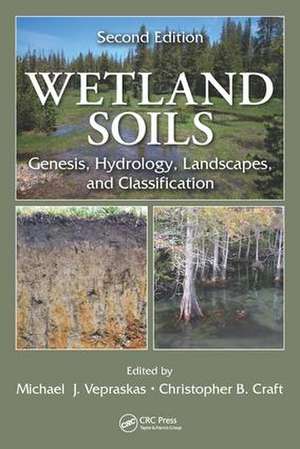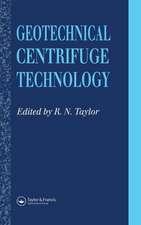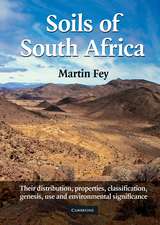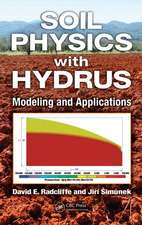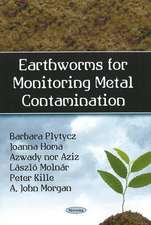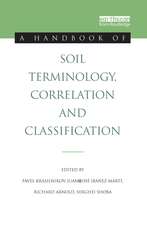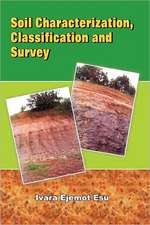Wetland Soils: Genesis, Hydrology, Landscapes, and Classification, Second Edition
Editat de Michael J. Vepraskas, Christopher B. Craften Limba Engleză Hardback – 2 dec 2015
Wetland Soils: Genesis, Hydrology, Landscapes, and Classification, Second Edition contains 11 new chapters and additional updates written by new authors with a broad range of related field and academic experience. This revised work augments the previous material on wetland functions and restorations, while maintaining the field-oriented focus of the first book. The reworked text includes current coverage of hydric soil field indicators, wetland soils, chemistry of wetland soils, and wetland hydrology. This book explains how wetland soils are formed, described, and identified, defines the functions they perform, and serves to assist decision-making in the field.
A specialized book specifically geared toward environmental consultants and governmental wetland regulators, the text:
- Reviews general properties of wetland soils, including hydrology, redox chemistry, organic matter dynamics and biology.
- Provides examples of major types of wetlands across the United States
- Highlights USDA Hydric Soil Field Indicators, the most current and universal indicators of wetlands soils
- Summarizes technical standards
- Evaluates wetland functions, methods of assessment, and restoration techniques
Preț: 1026.98 lei
Preț vechi: 1449.07 lei
-29% Nou
Puncte Express: 1540
Preț estimativ în valută:
196.52€ • 205.69$ • 163.56£
196.52€ • 205.69$ • 163.56£
Carte tipărită la comandă
Livrare economică 31 martie-14 aprilie
Preluare comenzi: 021 569.72.76
Specificații
ISBN-13: 9781439896983
ISBN-10: 1439896984
Pagini: 536
Ilustrații: 184 black & white illustrations, 26 colour illustrations, 58 black & white tables
Dimensiuni: 178 x 254 x 33 mm
Greutate: 1.13 kg
Ediția:Revizuită
Editura: CRC Press
Colecția CRC Press
ISBN-10: 1439896984
Pagini: 536
Ilustrații: 184 black & white illustrations, 26 colour illustrations, 58 black & white tables
Dimensiuni: 178 x 254 x 33 mm
Greutate: 1.13 kg
Ediția:Revizuită
Editura: CRC Press
Colecția CRC Press
Public țintă
Academic and Professional Practice & DevelopmentCuprins
BASIC PRINCIPLES OF HYDRIC SOILS. WETLAND SOIL LANDSCAPES. WETLAND FUNCTIONS AND RESTORATION.
Notă biografică
Michael J. Vepraskas is a William Neal Reynolds Distinguished Professor of Soil Science at North Carolina State University, where he is also head of the Soil Science Department. Currently, he specializes in wetlands with a focus on hydric soil formation and identification. His class on wetland soils is taught both on campus and online. In addition, he trains wetland consultants and regulators in identifying hydric soils through short courses that have been taught throughout the United States. He holds degrees from the University of Wisconsin in Madison (BS and MS) and Texas A&M University (PhD).
Christopher B. Craft is the Janet Duey Professor of rural land policy in the School of Public and Environmental Affairs at Indiana University, Bloomington. He earned degrees from the University of North Carolina-Ashville (BA, biology), the University of Tennessee (MS, ecology), and North Carolina State University (PhD, soil science). Professor Craft has over 30 years of experience working in inland freshwater and coastal wetlands. His research interests include wetland restoration, nutrient enrichment and eutrophication, carbon sequestration, and effects of climate change; his research projects span the Eastern, Midwest, and Western United States, Europe, and China.
Christopher B. Craft is the Janet Duey Professor of rural land policy in the School of Public and Environmental Affairs at Indiana University, Bloomington. He earned degrees from the University of North Carolina-Ashville (BA, biology), the University of Tennessee (MS, ecology), and North Carolina State University (PhD, soil science). Professor Craft has over 30 years of experience working in inland freshwater and coastal wetlands. His research interests include wetland restoration, nutrient enrichment and eutrophication, carbon sequestration, and effects of climate change; his research projects span the Eastern, Midwest, and Western United States, Europe, and China.
Recenzii
"This is an exceptional reference … a virtual encyclopedia on hydric soils written by the nation’s leading soil scientists offering readers a complete understanding of hydric soils, including the processes responsible for their development, their diagnostic properties, and how to delineate hydric soils in the field."
—Ralph Tiner, Institute for Wetland & Environmental Education & Research, Inc., University of Massachusetts, Amherst, USA
"The main strength is the comprehensiveness of the book. It covers all aspects of wetland soil characteristics including chemistry, hydrology, morphology, biota, classification, identification and delineation. … written in a way that anybody can understand and therefore it is useful to have it at hand."
—Jan Vymazal, Czech University of Life Sciences, Prague
"… an accessible, soil-centric perspective on the hydrologic, physical, chemical and biological phenomena that give rise to these enigmatic ecosystems. … stays true to the goal of providing students and practitioners with the basic science theory they need to understand wetland soils, and insights on how the science applies to practical applications."
—J. Patrick Megonigal, Smithsonian Environmental Research Center, Edgewater, Maryland, USA
"…offers a comprehensive coverage of wetland soils with great detail provided about their physical, chemical and morphological properties while simultaneously providing a strong national level review of their landscape associations. … maintains the essential sequencing of the original version with basic fundamental and underpinning topics being covered first, followed by applications, and then field landscape distributions … will continue to be the standard reference and textbook for both undergraduate and graduate courses and will also serve as an invaluable background resource for wetland professionals working in the field."
—W. Lee Daniels, Department of Crop & Soil Environmental Sciences, Virginia Tech, Blacksburg, USA
"… this book can serve as an excellent reference for students, professionals, consultants, and others involved in wetland science research and applications."
—Vadose Zone Journal, October 2016
—Ralph Tiner, Institute for Wetland & Environmental Education & Research, Inc., University of Massachusetts, Amherst, USA
"The main strength is the comprehensiveness of the book. It covers all aspects of wetland soil characteristics including chemistry, hydrology, morphology, biota, classification, identification and delineation. … written in a way that anybody can understand and therefore it is useful to have it at hand."
—Jan Vymazal, Czech University of Life Sciences, Prague
"… an accessible, soil-centric perspective on the hydrologic, physical, chemical and biological phenomena that give rise to these enigmatic ecosystems. … stays true to the goal of providing students and practitioners with the basic science theory they need to understand wetland soils, and insights on how the science applies to practical applications."
—J. Patrick Megonigal, Smithsonian Environmental Research Center, Edgewater, Maryland, USA
"…offers a comprehensive coverage of wetland soils with great detail provided about their physical, chemical and morphological properties while simultaneously providing a strong national level review of their landscape associations. … maintains the essential sequencing of the original version with basic fundamental and underpinning topics being covered first, followed by applications, and then field landscape distributions … will continue to be the standard reference and textbook for both undergraduate and graduate courses and will also serve as an invaluable background resource for wetland professionals working in the field."
—W. Lee Daniels, Department of Crop & Soil Environmental Sciences, Virginia Tech, Blacksburg, USA
"… this book can serve as an excellent reference for students, professionals, consultants, and others involved in wetland science research and applications."
—Vadose Zone Journal, October 2016
Descriere
Boundaries of a wetland must be identified and located in the field by examining three parameters: wetland plants, wetland hydrology, and hydric soils. This book explains how wetland soils are formed, described, and can be identified in the field. The new edition is a major revision of the 2000 book. Written by scientists with extensive field and academic experience, it contains 11 new chapters, updates throughout, and augments the previous material on wetland functions and restorations, while maintaining the field-oriented focus of the first book.
